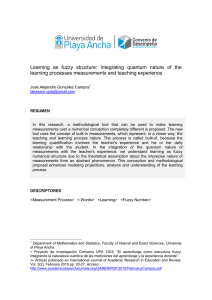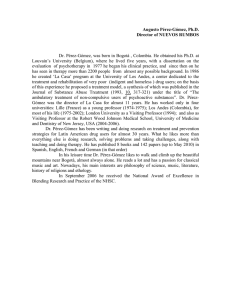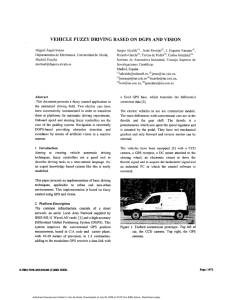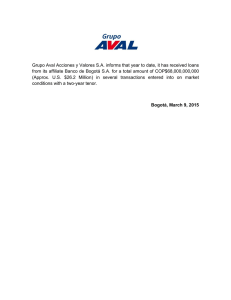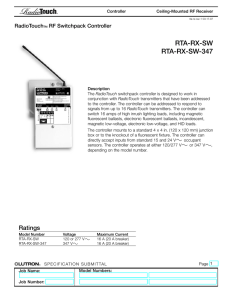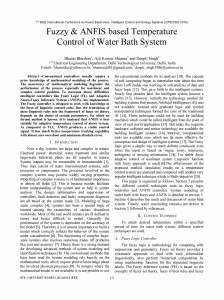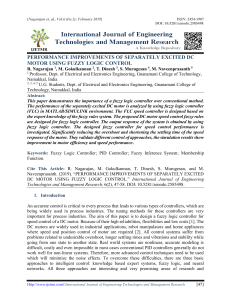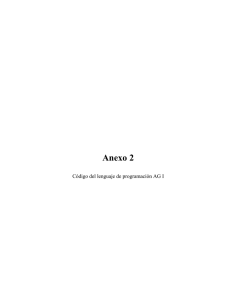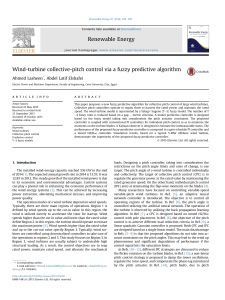PREDICTING THE INTENTION OF USING A
Anuncio
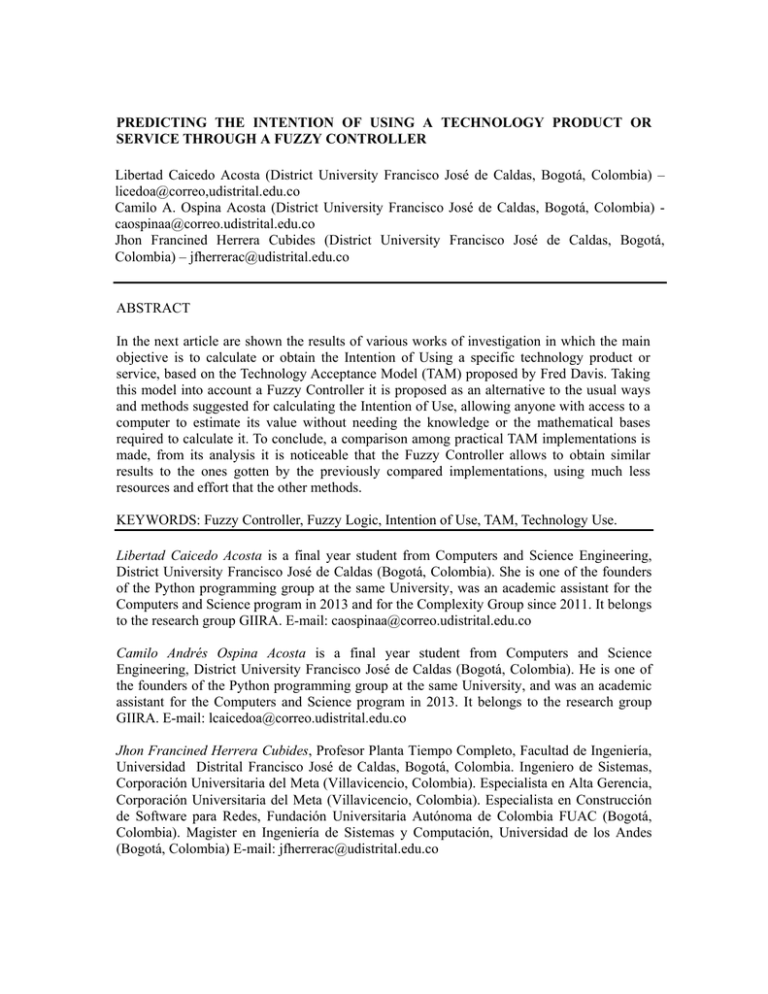
PREDICTING THE INTENTION OF USING A TECHNOLOGY PRODUCT OR SERVICE THROUGH A FUZZY CONTROLLER Libertad Caicedo Acosta (District University Francisco José de Caldas, Bogotá, Colombia) – licedoa@correo,udistrital.edu.co Camilo A. Ospina Acosta (District University Francisco José de Caldas, Bogotá, Colombia) caospinaa@correo.udistrital.edu.co Jhon Francined Herrera Cubides (District University Francisco José de Caldas, Bogotá, Colombia) – jfherrerac@udistrital.edu.co ABSTRACT In the next article are shown the results of various works of investigation in which the main objective is to calculate or obtain the Intention of Using a specific technology product or service, based on the Technology Acceptance Model (TAM) proposed by Fred Davis. Taking this model into account a Fuzzy Controller it is proposed as an alternative to the usual ways and methods suggested for calculating the Intention of Use, allowing anyone with access to a computer to estimate its value without needing the knowledge or the mathematical bases required to calculate it. To conclude, a comparison among practical TAM implementations is made, from its analysis it is noticeable that the Fuzzy Controller allows to obtain similar results to the ones gotten by the previously compared implementations, using much less resources and effort that the other methods. KEYWORDS: Fuzzy Controller, Fuzzy Logic, Intention of Use, TAM, Technology Use. Libertad Caicedo Acosta is a final year student from Computers and Science Engineering, District University Francisco José de Caldas (Bogotá, Colombia). She is one of the founders of the Python programming group at the same University, was an academic assistant for the Computers and Science program in 2013 and for the Complexity Group since 2011. It belongs to the research group GIIRA. E-mail: caospinaa@correo.udistrital.edu.co Camilo Andrés Ospina Acosta is a final year student from Computers and Science Engineering, District University Francisco José de Caldas (Bogotá, Colombia). He is one of the founders of the Python programming group at the same University, and was an academic assistant for the Computers and Science program in 2013. It belongs to the research group GIIRA. E-mail: lcaicedoa@correo.udistrital.edu.co Jhon Francined Herrera Cubides, Profesor Planta Tiempo Completo, Facultad de Ingeniería, Universidad Distrital Francisco José de Caldas, Bogotá, Colombia. Ingeniero de Sistemas, Corporación Universitaria del Meta (Villavicencio, Colombia). Especialista en Alta Gerencia, Corporación Universitaria del Meta (Villavicencio, Colombia). Especialista en Construcción de Software para Redes, Fundación Universitaria Autónoma de Colombia FUAC (Bogotá, Colombia). Magister en Ingeniería de Sistemas y Computación, Universidad de los Andes (Bogotá, Colombia) E-mail: jfherrerac@udistrital.edu.co RESUMEN En el siguiente artículo se muestran los resultados de varios trabajos de investigación, en los cuales el principal objetivo es calcular u obtener la intención de utilizar un servicio o producto tecnológico específico, basado en el modelo de aceptación tecnológica (TAM) propuesto por Fred Davis. Tomando en cuenta este modelo, se propone un controlador difuso como una alternativa a los métodos usualmente sugeridos para el cálculo de la intención de uso, permitiendo a cualquiera con acceso a un computador, estimar su valor sin necesitar el conocimiento o las bases matemáticas para ello. Para concluir, se realiza una comparación entre implementaciones prácticas del TAM, de lo cual se puede notar que el controlador difuso permite obtener resultados similares a los de las implementaciones previamente comparadas, usando muchos menos recursos y esfuerzo que otros métodos. PALABRAS CLAVE: Controlador difuso, lógica difusa, Intención de uso, TAM, Uso tecnológico. 1. INTRODUCTION Across last decades or so, an important topic to technology manufactures, including software and hardware, has been the capability to study the market so that the deployment of a product or service will not be a failure or does not fit the profit expectations (Varela, Rivas, Chaparro, 2010). To decrease the chances of falling, companies started getting involved with Strategic Planning, which allowed them to gain control over the needs and components of the business. In this way, it emerges a model for Strategic Planning developed by Jhon Rockart called Critical success factors (Bullen & Rockart, 1981), which allowed Enterprises to find which elements where indeed necessary, or had more value so that the company could fulfill its mission. Through the same period it jump out to notice that Information and Communications Technologies were very important within the critical success factors (Davis, Bagozzi, Warshaw, 1989; Davis, 1989; Renaud &Van, 2008). Based on this facts, Fred Davis developed it´s model for Technology Acceptance (Davis, 1986), which in its classical version involved two variables to calculate the Intention of Use, allowing establishing the real use of a technology product or service. This Model, has been used through all of these years in an acceptable manner, although it presents several disadvantages. In this way, within an academic investigation context, through the District University Francisco José de Caldas’s GIIRA group, it is proposed a project that seeks solving the Technology Acceptance Model disadvantages, analyzing and identifying its phases to automate a very important process. The bounds of the project are linked to the Classical Technology Acceptance Model in which only two variables (in a specific range) are taken into account for the model, as well as the existence of enough practical implementations to validate the proposed solution. It is important to clarify that project scope is projected to design, implement and validate a Fuzzy Controller for predicting the intention of using a technology product or service. 2. PREDICTING USER INTENTIONS As previously told, enterprises began to get interested in developing Information systems that were effective, and therefore the creation of various techniques, models and strategies were needed. In this way the Theory of Planned Behavior appeared as an alternative to other acceptance models, this theory involved three (3) factors for being able to determine the intention of use, including some social variables that affect it. Although this theory is really similar to the technology acceptance model, they differ in the degree of generality and the complexity to apply them, being the Theory of Planned Behavior more difficult to apply across various user contexts, requiring pilot studies to identify relevant outcomes and control variables for each context in which is used (Mathieson, 1991). In this way this article will focus in the technology acceptance model, for being a tool more practical to implement in several cases. Now a days exist a lot researches and works about the technology acceptance model, which in the words of some, may have saturated the usefulness of the model, requiring some new ways of calculating the intention of use that integrate the good thing from the model and eliminate its deficiencies, which is exactly what this article seeks (Chuttur, 2009). 3. TECHNOLOGY ACCEPTANCE MODEL The Technology Acceptance Model (TAM), proposed and developed by Fred Davis in 1989, arises from the need of being able of predicting the Intention of Use of a technology product or service, by establishing a set of relevant analysis variables for accomplishing this. The model input variables were chosen based on the adoption of the attitude psychological principles proposed by Fishbein and Ajzen’s (Ajzen & Fishbein, 1977). On a large scale TAM comprehends three (3) fundamental aspects: it take into account a variable amount of factors that affect the perceived usefulness and ease of use, it gives a priori criteria of the acceptance degree of a product or service to produce and it validates the real acceptance degree of it. From these, three (3) phases can be associated to each aspect previously mentioned: 1. Identification and calculation of variables: On this phase are established which variables are going to dictate the usefulness and ease of use, calculated in a range from zero (0) to one (1) through surveys and statistical methods. 2. Prediction of the Intention of Use: Through the calculated values on the first phase, a mathematical model that takes into account all variables relations and their corresponding weights is implemented, to predict the Intention of Use. 3. Results Validation: This is an optional phase that is performed once the final users are making use of the product or service, and its final purpose is to establish the effectiveness of the prediction made on phase two (2). On figure 1 is represented the TAM, which will be later used to perform a comparison between practical implementations of the model against the proposed Fuzzy Controller. Figure 1. TAM. Source: authors. From the analysis of various TAM implementations the following deficiencies were found: It doesn't exist a unique methodology that establishes the correct form of implementing the three (3) phases, making subjective the obtained results from the model (Venkatesh, Davis, Davis, Morris, 2003; Washaw et al, 1989). It requires a mathematical knowledge in the implementation of all of it phases (López & López, 2006). It requires a complete knowing of the model to be able to implement it (Leyton, 2013). It is difficult to use to the majority of the people, and it requires experts to implement it (Leyton, 2013). The results interpretation is difficult to comprehend without understanding the model and the mathematical bases (Leyton, 2013). The model implementation difficult getting agile and timely results (Leyton, 2013). The model implementation have high costs in terms of time and money for a regular person or a small company (Leyton, 2013). To solve all of above problems a Fuzzy Controller was design based on the same inputs and outputs proposed by TAM. This model is different in many ways from the one proposed by Fred Davis, but mainly because it is based on several rules that allow the controller to establish the Intention of Use. 4. CONTROLLER DESIGN The proposal of using a controller, instead of other possible tools, emerges from the fact that the problem have various characteristics that can be well represented through the Fuzzy Logic; it can represent a set of rules; it manages fuzzy ranges that explicitly specify the human language subjectivity; and provides a more understandable way of representing the problem (Chuen, 1990). Also, the idea of making a Fuzzy Controller to replace phase II of the model, is to change some qualitative values proposed by TAM to a quantitative range of results, which require less effort to be calculated. On this way a Fuzzy Controller with two (2) inputs and one (1) output is proposed to calculate the Intention of Use as shown on figure 2. Figure 2. Fuzzy Controller. Source: authors. To design the controller, the following rules were defined taking into account the inputs and outputs propose by Fred Davis and the results obtained from various TAM implementations, as can be seen on figure 3: Figure 3. Controller's Rules. Source: authors. On figure 4 are shown the corresponding membership functions for all inputs and outputs of the Fuzzy Controller, which vary in a range from 0 to 1, where the Low and High functions are of Trapezoidal-Shaped Type and the Med function is a Triangular-Shaped type. Figure 4. Membership Functions. Source: authors From designing the Fuzzy Controller is obtained as result the rules surface at figure 5, which represents in a graphical way the previous mentioned rules. Figure 5. Rules Surface. Source: authors. 5. PRACTICAL TAM IMPLEMENTATIONS Through the analysis of various TAM implementations and investigation works from experts (Villarejo, 2007; Tavera & Arias, 1990; Ramírez & Alfaro, 2012; Davis, 1991; Venkatesh & Davis, 2000; Rejón, Liebana, Martínez, 2011) the Table 1 is created, showing the results of calculating the Intention of Use employing the Ease of Use and Usefulness as the only parameters to do so. Implementation of TAM Usefulness Ease of Use Intention of Use 0,3550 0,2280 0,3380 0,5720 0,3280 0,5390 0,1700 0,3000 0,3400 0,6500 0,1300 0,2100 0,4600 0,4500 0,4400 0,5500 0,1700 0,5200 0,6400 0,3500 0,6900 Table 1. Analysis of TAM Implementations. Source: authors The previous table shows the results from works of various kinds, which used different TAM implementations that took into account diverse external variables, as well as managed different budgets and implementation times. Through the results shown on this table is later made a comparison to test the effectiveness of the proposed Fuzzy Controller. 6. RESULTS COMPARISON After creating the controller, which has suffered several changes to give the best possible result so far, a comparison between the obtained results of the practical implementations and the Fuzzy Controller is made, taking into account a literature review of the model background. Thereby Table 2 represents both results with their respective difference. Intention of Use TAM IMP. Fuzzy Controller Difference 0,3380 0,3424 0,0044 0,5390 0,4930 0,0460 0,3400 0,2880 0,0520 0,2100 0,3349 0,1249 0,4400 0,4386 0,0014 0,5200 0,4348 0,0852 0,6900 0,4998 0,1902 Table 2. Results Comparison. Source: authors. From the results obtained from the Fuzzy Controller is already noticeable that various of the TAM deficiencies have been reduced, leading to simplifying the use the model and reduction of costs in terms of time and money, improving the ability to get agile and timely results as well as the ability of comprehend the results, all of this without having to implement any mathematical methods and still getting similar results with much less effort. 7. CONCLUSIONS The implementation of a Fuzzy Controller reduces the human interaction for calculating the ''Intention of Use'' and therefore reduces the chances of making mistakes on this calculations. It is noticeable that although it is a much simpler process to implement, the obtained results does not change much which the ones given by humans applying the TAM Model. It avoids requiring knowledge of mathematics, statistics and the complete structure of the model to implement phase II of TAM. The Fuzzy Controller allows reduce the dependency from humans to calculate the ''Intention of Use'' and reduces costs almost to cero to anyone who want to implement it. For future investigations a set of different optimization algorithms can be implemented to get a much more precise controller, as well as a bigger amount of rules and input variables can be added to improve the prediction. A software solution is recommended, through the use of Fuzzy Logic libraries, allowing to get a portable implementation. Finally yet importantly, breaks with the qualitative problem of different people having different implementations of the model for a same problem. REFERENCES Ajzen, I.; Fishbein, M.(1977). Attitude-behavior relations: a theoretical analysis and review of empirical research. Psuchological Bulletin. Vol. 84, pp. 88-918. Bullen, C.; Rockart, J. F.(1981). A primer on critical success factors. Center for Information Systems Research, Sloan School of Management,HD28 .M414 no.1220-, 81. Chuen, L. (1990). Fuzzy logic in control system: Fuzzy logic -Part I. IEEE Tran. on Syst. Man and Cyber,Vol. 20, pp.404-418. Chuttur, M.Y. (2009). Overview of the Technology Acceptance Model: Origins, Developments and Future Directions , Indiana University, USA . pp 1-17. Davis, F.D.(1986). A Technology Acceptance Model for Empirically Testing New End-User Information Systems: Theory and Results. doctoral dissertation, MIT Sloan School of Management, Cambridge, MA. Davis, F.D.; Bagozzi, R.P.; Warshaw, P.R.(1989). User Acceptance of Computer Technology: A Comparison of Two Theoretical Models. Management Science,August, pp.982-1 No 003. Davis, F.D.(1989). Perceived Usefulness, Perceived Ease of Use, and User Acceptance of Information Technology. Management Information Systems Research Center, University of Minnesota,Vol. 13, No. 3., pp. 319-340. Davis, F. (1991). User acceptance of information technology: system characteristics, user perceptions and behavioral impacts. Machine Studies, pp.481-482. Mathieson, T. (1991). Predicting User Intentions: Comparing the Technology Acceptance Model with the Theory of Planned Behavior. Oaklan University. Vol. 2, No. 3, pp. 173-191. Leyton, D. A. (2013). Extensión al modelo de aceptación de tecnología tam, para ser aplicado a sistemas colaborativos, en el contexto de pequeñas y medianas empresas. Universidad de Chile, pp. 75-76. López, L.; López, J.(2006). Estudio Comparado de las Estimaciones de dos Versiones del Modelo de Aceptación de la Tecnología (TAM) Mediante los Programas AMOS Y PLS. BSEE, Universidad de Sevilla, Vol. 12, Nº 3. Ramírez, P.; Alfaro, J. (2012). Estudio exploratorio del impacto de la red social en el nivel individual de aceptación de sistemas empresariales. Ingeniare. Revista chilena de ingeniería, vol. 20 Nº 1, pp. 40-47. Rejón, F; Liebana, F. J.; Martínez, M. (2011). Factores motivacionales de la aceptación de redes sociales de microblogging: modelo mbtam. Girona, pp.11-12. Renaud, K.; Van, J.(2008). Predicting Technology Acceptance and Adoption by the Elderly: A Qualitative study. School of Computing, University of South Africa South Africa,Department of Computing Science, University of Glasgow, Glasgow, Scotland,pp. 210-219. Tavera, J.; Arias, J. (1990). Internet móvil: Aceptación tecnológica para el cierre de la brecha digital en Colombia. Perfil de Coyuntura Económica Universidad de Antioquia, No. 19, pp. 139-155. Varela , A.; Rivas, L; Chaparro, J. (2010). TAM : un estudio de la influencia de la cultura nacional y del perfil del usuario en el uso de las TIC. Río Nilo No. 13, Depto. 502, Col. Cuauhtemoc, CP. 06500, México D.F. Venkatesh, V.; Davis, F(2000). A Theoretical Extension of the Technology Acceptance Model: Four Longitudinal Field Studies. Management Science , Vol. 46, No. 2, pp. 186-204. Venkatesh, V. ; Morris, M. ; Davis, G. ; Davis, F. (2003). User Acceptance of Information Technology: Toward a Unified View. MIS Quarterl, Vol. 27, No. 3, pp. 425-478. Villarejo, A. (2007). Un modelo empírico de adaptación y uso de la Web. Utilidad, facilidad de uso y flujo percibidos. Universidad de Sevilla. Departamento de Administración de Empresas y Marketing,Facultad de Ciencias Económicas y Empresariales, Universidad de Sevilla. Avda. Ramón y Cajal, nº 1. pp. 41018. Warshaw, P. ; Bagozzi, R. ; Davis, F. (1989). User Acceptance of Computer Technology: A Comparison of Two Theoretical Models. Management Science,Vol. 35, No. 8, pp. 982-1003.
